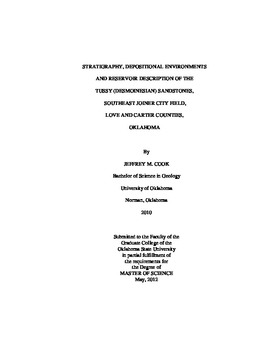| dc.contributor.advisor | Puckette, James O. | |
| dc.contributor.author | Cook, Jeffrey Manning | |
| dc.date.accessioned | 2015-01-05T15:54:40Z | |
| dc.date.available | 2015-01-05T15:54:40Z | |
| dc.date.issued | 2012-05 | |
| dc.identifier.uri | https://hdl.handle.net/11244/14046 | |
| dc.description.abstract | Scope and Method of Study: The Pennsylvanian (Desmoinesian) Tussy sandstones were studied in the Southeast Joiner City field of Love and Carter Counties, Oklahoma. Data collected from two cores, conventional wireline logs and borehole-image logs were analyzed and interpreted. This set of data permitted interpretations of the stratigraphic framework, depositional environments, and reservoir quality, geometry and distribution for the Tussy sandstones within the Southeast Joiner City Field. | |
| dc.description.abstract | Findings and Conclusions: The Tussy interval is defined as the set of strata between the Tussy Limestone at the top and the Upper Dornick Hills Group at the base. Analysis of cross-sections revealed a southerly thickening of the Tussy interval, and rose plots of bedding dips show a dominant north-to-south sediment transport direction. Thus, the basin depocenter was south of the Southeast Joiner City field during Tussy deposition. | |
| dc.description.abstract | The Tussy A and B cored intervals are rocks that were deposited in marine, fluvial, floodplain and estuarine environments; they show evidence of sea-level cyclicity. Eleven core-derived facies were interpreted, each with distinct sedimentary structures and reservoir quality. Characteristics of the lithotypes from analyses of core, thin-sections and core-derived porosity and permeability data reveal that grain-size, degree of cementation and clay content are the major controls on reservoir quality. The best reservoir facies are of coarse grain-size, are poorly cemented, and have small amounts of pore-clogging clays. | |
| dc.description.abstract | The Tussy A and B sandstones were interpreted as meandering stream deposits, composed of amalgamated and laterally connected, side-attached point-bar deposits within a channel belt. This conclusion is based on sedimentary structures, sand-body geometry and sand-body distribution patterns which resemble modern analogues of meander belts. | |
| dc.format | application/pdf | |
| dc.language | en_US | |
| dc.rights | Copyright is held by the author who has granted the Oklahoma State University Library the non-exclusive right to share this material in its institutional repository. Contact Digital Library Services at lib-dls@okstate.edu or 405-744-9161 for the permission policy on the use, reproduction or distribution of this material. | |
| dc.title | Stratigraphy, depositional environments and reservoir description of the Tussy (Desmoinesian) sandstones, Southeast Joiner City field, Love and Carter Counties, Oklahoma | |
| dc.contributor.committeeMember | Boardman, Darwin R. | |
| dc.contributor.committeeMember | Stewart, Gary F. | |
| osu.filename | Cook_okstate_0664M_12115.pdf | |
| osu.accesstype | Open Access | |
| dc.type.genre | Thesis | |
| dc.type.material | Text | |
| dc.subject.keywords | deese | |
| dc.subject.keywords | petroleum geology | |
| dc.subject.keywords | reservoir characterization | |
| dc.subject.keywords | sedimentology | |
| dc.subject.keywords | stratigraphy | |
| dc.subject.keywords | subsurface geology | |
| thesis.degree.discipline | Geology | |
| thesis.degree.grantor | Oklahoma State University | |
